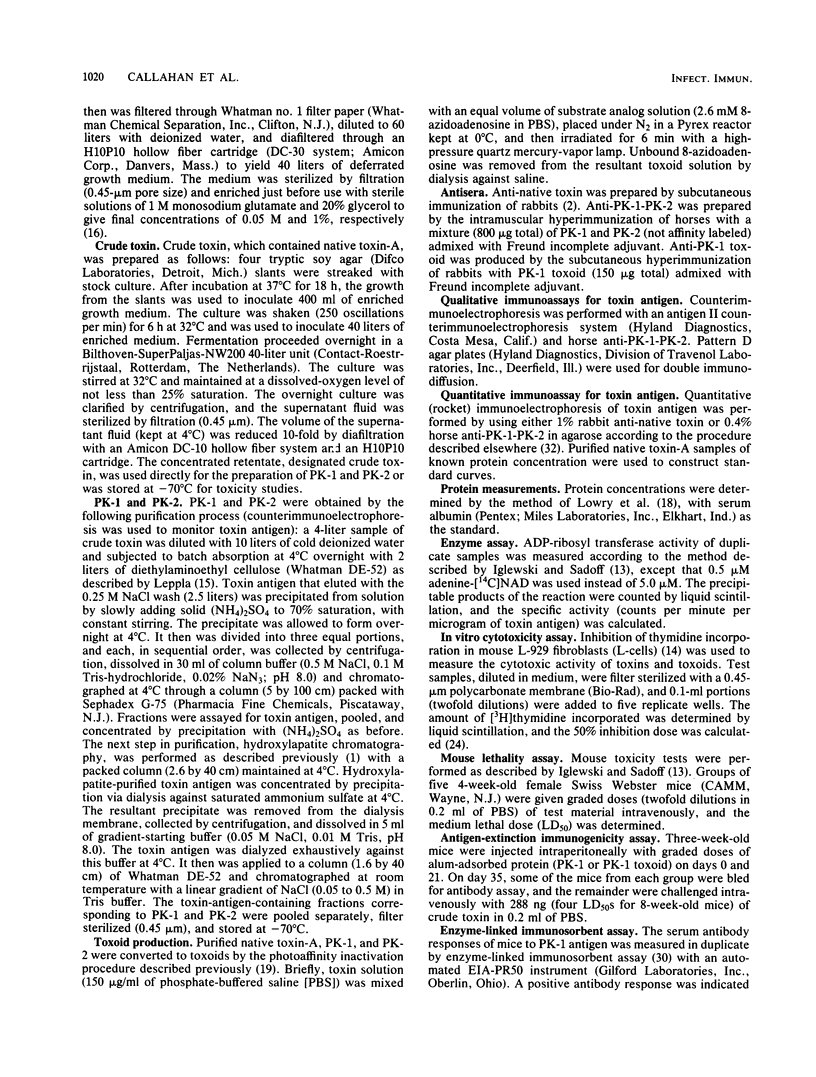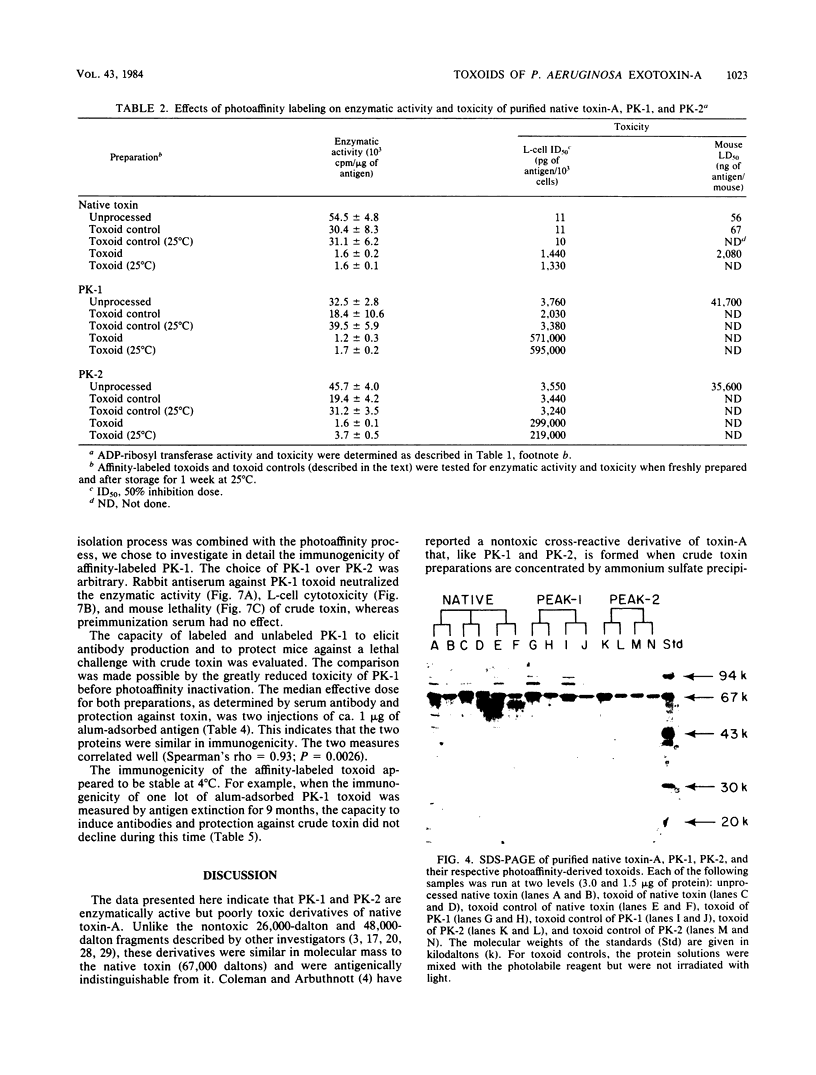Abstract
For the preparation of greatly detoxified but highly immunogenic toxoids, two enzymatically active, low-toxicity derivatives of Pseudomonas aeruginosa exotoxin-A were further inactivated by photoaffinity labeling. These derivatives were formed during toxin purification, when a relatively crude toxin preparation was concentrated by ammonium sulfate precipitation and subsequently dialyzed. These derivatives, designated peak-1 protein (PK-1) and peak-2 protein (PK-2) were antigenically indistinguishable from native toxin, but had isoelectric points (5.00 and 4.90, respectively) that were different from that of the native toxin (4.95). Although the enzymatic activities and molecular weights of PK-1 and PK-2 were similar to those of native toxin, their toxicities were greatly reduced (ca. 500-fold). Photoaffinity labeling of fully active toxin-A, purified by a process which limits the formation of these derivatives, decreased its enzymatic activity (ca. 30-fold) and toxicity (ca. 100-fold). Likewise, photoaffinity labeling of purified PK-1 and PK-2 decreased their enzymatic activities and toxicities (ca. 30-fold and 100-fold, respectively) and, thus, yielded toxoids that were ca. 50,000-fold less toxic than unpurified native toxin. These toxoids were irreversibly detoxified and highly immunogenic during 9 months of storage at 4 degrees C.
Full text
PDF







Images in this article
Selected References
These references are in PubMed. This may not be the complete list of references from this article.
- Callahan L. T., 3rd Pseudomonas aeruginosa exotoxin: purification by preparative polyacrylamide gel electrophoresis and the development of a highly specific antitoxin serum. Infect Immun. 1976 Jul;14(1):55–61. doi: 10.1128/iai.14.1.55-61.1976. [DOI] [PMC free article] [PubMed] [Google Scholar]
- Callahan L. T., 3rd Purification and characterization of Pseudomonas aeruginosa exotoxin. Infect Immun. 1974 Jan;9(1):113–118. doi: 10.1128/iai.9.1.113-118.1974. [DOI] [PMC free article] [PubMed] [Google Scholar]
- Chung D. W., Collier R. J. Enzymatically active peptide from the adenosine diphosphate-ribosylating toxin of Pseudomonas aeruginosa. Infect Immun. 1977 Jun;16(3):832–841. doi: 10.1128/iai.16.3.832-841.1977. [DOI] [PMC free article] [PubMed] [Google Scholar]
- Cryz S. J., Jr, Friedman R. L., Pavlovskis O. R., Iglewski B. H. Effect of formalin toxoiding on Pseudomonas aeruginosa toxin A: biological, chemical, and immunochemical studies. Infect Immun. 1981 May;32(2):759–768. doi: 10.1128/iai.32.2.759-768.1981. [DOI] [PMC free article] [PubMed] [Google Scholar]
- DAVIS B. J. DISC ELECTROPHORESIS. II. METHOD AND APPLICATION TO HUMAN SERUM PROTEINS. Ann N Y Acad Sci. 1964 Dec 28;121:404–427. doi: 10.1111/j.1749-6632.1964.tb14213.x. [DOI] [PubMed] [Google Scholar]
- FitzGerald D., Morris R. E., Saelinger C. B. Receptor-mediated internalization of Pseudomonas toxin by mouse fibroblasts. Cell. 1980 Oct;21(3):867–873. doi: 10.1016/0092-8674(80)90450-x. [DOI] [PubMed] [Google Scholar]
- Fitzgerald D., Morris R. E., Saelinger C. B. Essential role of calcium in cellular internalization of Pseudomonas toxin. Infect Immun. 1982 Feb;35(2):715–720. doi: 10.1128/iai.35.2.715-720.1982. [DOI] [PMC free article] [PubMed] [Google Scholar]
- Gill D. M. Bacterial toxins: a table of lethal amounts. Microbiol Rev. 1982 Mar;46(1):86–94. doi: 10.1128/mr.46.1.86-94.1982. [DOI] [PMC free article] [PubMed] [Google Scholar]
- Iglewski B. H., Kabat D. NAD-dependent inhibition of protein synthesis by Pseudomonas aeruginosa toxin,. Proc Natl Acad Sci U S A. 1975 Jun;72(6):2284–2288. doi: 10.1073/pnas.72.6.2284. [DOI] [PMC free article] [PubMed] [Google Scholar]
- Iglewski B. H., Sadoff J. C. Toxin inhibitors of protein synthesis: production, purification, and assay of Pseudomonas aeruginosa toxin A. Methods Enzymol. 1979;60:780–793. doi: 10.1016/s0076-6879(79)60071-x. [DOI] [PubMed] [Google Scholar]
- Knudsen R. C., Callahan L. T., 3rd, Ahmed A., Sell K. W. Use of microculture plates and the multiple automated sample harvester for in vitro microassay of bacterial toxins. Appl Microbiol. 1974 Aug;28(2):326–327. doi: 10.1128/am.28.2.326-327.1974. [DOI] [PMC free article] [PubMed] [Google Scholar]
- LOWRY O. H., ROSEBROUGH N. J., FARR A. L., RANDALL R. J. Protein measurement with the Folin phenol reagent. J Biol Chem. 1951 Nov;193(1):265–275. [PubMed] [Google Scholar]
- Leppla S. H. Large-scale purification and characterization of the exotoxin of Pseudomonas aeruginosa. Infect Immun. 1976 Oct;14(4):1077–1086. doi: 10.1128/iai.14.4.1077-1086.1976. [DOI] [PMC free article] [PubMed] [Google Scholar]
- Liu P. V. Exotoxins of Pseudomonas aeruginosa. I. Factors that influence the production of exotoxin A. J Infect Dis. 1973 Oct;128(4):506–513. doi: 10.1093/infdis/128.4.506. [DOI] [PubMed] [Google Scholar]
- Lory S., Collier R. J. Expression of enzymic activity by exotoxin A from Pseudomonas aeruginosa. Infect Immun. 1980 May;28(2):494–501. doi: 10.1128/iai.28.2.494-501.1980. [DOI] [PMC free article] [PubMed] [Google Scholar]
- Marburg S., Tolman R. L., Callahan L. T., 3rd Pseudomonas exotoxin A: toxoid preparation by photoaffinity inactivation. Proc Natl Acad Sci U S A. 1983 May;80(10):2870–2873. doi: 10.1073/pnas.80.10.2870. [DOI] [PMC free article] [PubMed] [Google Scholar]
- Morihara K., Sanai Y., Tsuzuki H., Jyoyama H., Hirose K., Homma J. Y., Kato I. Effects of proteases on the structure and activity of Pseudomonas aeruginosa exotoxin A. Infect Immun. 1981 Nov;34(2):435–440. doi: 10.1128/iai.34.2.435-440.1981. [DOI] [PMC free article] [PubMed] [Google Scholar]
- Morris R. E., Manhart M. D., Saelinger C. B. Receptor-mediated entry of Pseudomonas toxin: methylamine blocks clustering step. Infect Immun. 1983 May;40(2):806–811. doi: 10.1128/iai.40.2.806-811.1983. [DOI] [PMC free article] [PubMed] [Google Scholar]
- Morrissey J. H. Silver stain for proteins in polyacrylamide gels: a modified procedure with enhanced uniform sensitivity. Anal Biochem. 1981 Nov 1;117(2):307–310. doi: 10.1016/0003-2697(81)90783-1. [DOI] [PubMed] [Google Scholar]
- Pollack M., Callahan L. T., 3rd, Taylor N. S. Neutralizing antibody to Pseudomonas aeruginosa exotoxin in human sera: evidence for in vivo toxin production during infection. Infect Immun. 1976 Oct;14(4):942–947. doi: 10.1128/iai.14.4.942-947.1976. [DOI] [PMC free article] [PubMed] [Google Scholar]
- Pollack M., Prescott R. K. Toxoid from exotoxin A of Pseudomonas aeruginosa: preparation and characterization. J Infect Dis. 1982 May;145(5):688–698. doi: 10.1093/infdis/145.2.688. [DOI] [PubMed] [Google Scholar]
- Pollack M., Young L. S. Protective activity of antibodies to exotoxin A and lipopolysaccharide at the onset of Pseudomonas aeruginosa septicemia in man. J Clin Invest. 1979 Feb;63(2):276–286. doi: 10.1172/JCI109300. [DOI] [PMC free article] [PubMed] [Google Scholar]
- Sanai Y., Morihara K., Tsuzuki H., Homma J. Y., Kato I. Proteolytic cleavage of exotoxin A from Pseudomonas aeruginosa: formation of an ADP-ribosyltransferase active fragment by the action of Pseudomonas elastase. FEBS Lett. 1980 Oct 20;120(1):131–134. doi: 10.1016/0014-5793(80)81063-5. [DOI] [PubMed] [Google Scholar]
- Vasil M. L., Kabat D., Iglewski B. H. Structure-activity relationships of an exotoxin of Pseudomonas aeruginosa. Infect Immun. 1977 Apr;16(1):353–361. doi: 10.1128/iai.16.1.353-361.1977. [DOI] [PMC free article] [PubMed] [Google Scholar]
- Weber K., Osborn M. The reliability of molecular weight determinations by dodecyl sulfate-polyacrylamide gel electrophoresis. J Biol Chem. 1969 Aug 25;244(16):4406–4412. [PubMed] [Google Scholar]







